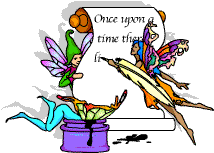The Invention of Fairies
Created | Updated Apr 18, 2003
Introduction

The world of fairies. When someone hear these words, he thinks of Tinkerbell. The general association is tiny beautiful ladies with fragile transparent wings and magical powers (see picture at the right).
In this research the term "fairies" will be used a bit differently. The term "fairies" will describe ANY legendary creature that has the human figure as its basic appearance model, no matter how twisted the form is and how different its qualities are. For example- Trolls apply to this description and Dragons don't. This approach was adopted from the book Faeries by Alan Lee and Brian Frond and very much fit this research.
As for other mythical creatures such as dragons, basiliscs and pegasus, which are not humanoids in form, they will not be reffered here, because it seems that the reasons for their creation are different in a way.
But do these fairies really exist? This question has two possible answers, which are both almost equally unprovenable (if you find a fairie then you have proven it exists, but on the logical level it is not that simple), and therefore one can believe and investigate either answer, according to his whims. This research comes to investigate the answer "NO".
So, in case fairies don't exist, how come we have stories about them in every known culture around the world? It seems that the need for the creation of fairies, it's reason, is embedded within the human nature. This reason is the goal of this research.
The basic assumption of this research is that this reason is based on the curiousity of the human race, its need to explain things it sees and fears. Therefore, assuming that the human nature hasn't changed much since the invention of fairies 1
, the first place to look for an answer, is today's psychology.
And Now, The Research
In order to discover what are the reasons for the creation of the world of fairies, this research's first address was Sigmund Freud, who speaks in his book "Totem and Taboo" about animism. Animism is a form of belief according which every object and creature has a living soul. It seems that this belief is the root of the world of fairies. Fairies are a more advanced form of the nature's soul, a form that gives it a more physical definition.
While reading Freud, three sentences were encountered, sentences that would answer this research's question:
- "If primitive man reacted to the phenomena that stimulated his reflection with the formation of conseptions of the soul, and then transferred these to objects of the outer world, his attitude will be judged to be quite natural and in no way mysterious."(S. Freud)
- "Primitive animism may be looked upon as the spiritual expression of man's natural state."(W. Wundt)
- "There is a universal tendancy among mankind to concieve all beings like themselves and to transfer to every object those qualities with which they are fammiliar and acquainted and of which they are intimately concious."(D. Hume)
It seems that the answer is to feel safe. The human race is different from other races- it has the ability to think 2. While developing this ability, the human race separated itself from the rest of nature, and by doing that broke the harmony that once existed. Now, the human race is afraid of what it had done, and wants to fix it. There are two methods of doing that. The first is to change the nature of the human race and match it with Nature's. This method is implemented especially in far-eastern life doctrines such as Taoism, but is far less common than the second method- changing nature so it will match you. The nature of the human race inclines to this method, probably because it thinks it is better that nature. The human race had many different ways to apply this method throughout history, getting more aggressive and controlling each time.
In the present, humans make a very aggressive vitriolic change in nature, which can be seen in many aspects such as the covering of the world by asphalt, the harnessing of nature's forces to the benefit of mankind, the vast killing of animals and plants worldwide, and many other things.
In the relatively close past, the change humans applied upon nature was the creation of nature's creator(s) by mankind- the god(s). The god(s) usually look like human beings (even God-Almighty of the monotheistic religions 3 ) and control nature. Humans "control" the god(s) by praying to them, therefore getting the feeling they can control nature if they ask nicely.
In the more distant past, before the invention of religion, humans' change was animism. The human race gave life to nature, life that is similar to his. After a while, he created creatures that live in nature and give it its life. These creatures are the fairies. They were built in the form of man-shorter, higher, stronger, weaker, magical, with extra/without some limbs, but basically like nature. One fact which is important to add is that humans haven't yet realized that they can control nature, or that the even want to do so, and therefore, put themselves in a lower level that the fairies and later the gods.
Summary
For summary, the conclusion of this research is that the reason for the creation of fairies comes from basic features of the human nature: The human race is different from the rest of nature, and he is afraid of that difference. Humans need to be similar. But humans are controlling. Therefore, they won't change themselves. They will change nature. Today, they use physical methods. In the past they used mental ones- creating a world of creatures obviously bound strictly to nature, but with human characteristics.
